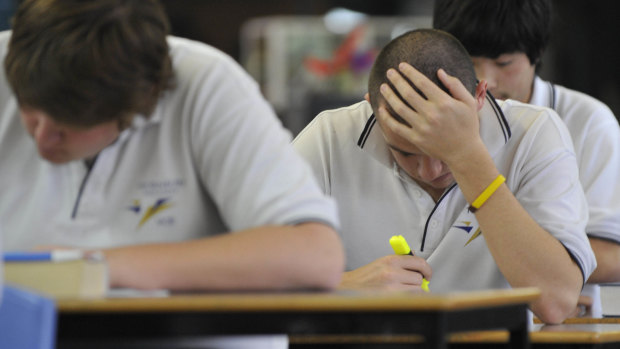By Jordan Baker
Australian students have recorded their worst results in international tests, failing for the first time to exceed the OECD average in maths while also tumbling down global rankings in reading and science.
The results were particularly bad for NSW, which recorded the country's biggest drop in both reading and science over the period since Programme for International Student Assessment (PISA) tests began in the early 2000s. The state also recorded significant declines in mathematics.
Since 2003, Australia's results in maths have declined further than any country but Finland. Compared with the top-performer, Singapore, the students who sat the test last year were three years behind in maths, a year and three months behind in reading, and a year and nine months behind in scientific literacy.

Australian students have recorded their worst results in international tests, according to PISA.Credit: Wayne Taylor
They were also more than a year behind the 15-year-old Australian students who sat the original tests in the early 2000s.
Education Minister Dan Tehan said "these results should have alarm bells ringing" and urged his state and territory counterparts to take "ambitious" action at next week's Education Council meeting.
PISA is held every three years to test how well students in their final years of school apply their knowledge to real-life challenges. In 2018, it was sat by more than 14,000 15-year-old Australians from 740 schools, joining 600,000 students from 79 countries.
The leading countries included Hong Kong, Macau, and Japan. Former PISA star Finland was outshone by Europe's new standout, Estonia. The best-performing English-speaking country was Canada.
PISA national project manager, Sue Thomson, said Australian students were either declining or treading water while other countries in the OECD were improving. "There's no sign of any change," she said. "There's no sign of anything recovering.
"The line in the sand moment for me is that we are at the [Organisation for Economic Co-operation and Development] average in maths. We have always been above it. It means our kids aren't getting the skills they need to cope in a globalised world.
"This has got to be a wake-up call. It's got to be a point where we say, 'if we don't do something now, then next time I'll have to stand here and report that we are below the OECD average'."
Since PISA began in 2000, the proportion of Australian students among the low performers has increased, the high performers have decreased, and fewer students are meeting the National Proficient Standard - a "challenging but reasonable" expectation - in each subject.
PISA began testing maths in 2003. NSW has declined by 38 points, with only South Australia, Western Australia and Tasmania dropping further - some of the biggest falls in the OECD.
Between 2015 and 2018 there was little change in Australia's maths and reading performance, but the country tumbled because other countries improved. Scientific literacy declined over the past three years, especially in NSW.
The state also recorded the biggest drop in scientific literacy since that test began in 2006, with more low performers, and fewer high performers. "Kids have to read to do science," Dr Thomson said. "That could be one of the explanations for the decline."
NSW's reading results were particularly poor; its fall since 2000 has been the biggest in Australia, and in 2018 the state's students beat those from the Northern Territory and Tasmania, which are traditionally the country's lowest-performing jurisdictions.
They were about a year behind students from the top-performing ACT. Only 56 per cent of NSW students attained the national standard in reading, compared with 62 per cent from Victoria, which has avoided major declines.
"Victoria has managed to hang in there," Dr Thomson said. "Perhaps we need to look to Victoria to see what their answers are."
Overall, Australia's most disadvantaged students were three years behind the most advantaged ones, a wider gulf than the gap between Indigenous and non-Indigenous students.
When socio-economic factors were taken into account, independent, Catholic and government schools achieved similar results in science and reading. In maths, the government system out-performed Catholic schools.
On unadjusted scores, independent and Catholic schools achieved higher results, but analysts were surprised by the extent of the fall in the independent system, which "we would not have expected," said Dr Thomson.
Mr Tehan called on states and territories to focus on a "back to basics" approach, including implementing phonics for early readers. "We have a clear road map to implement the reforms that will improve student outcomes and we should be bold and decisive," he said.
But Geoff Masters, the chief executive officer of the Australian Council for Educational Research (ACER), which runs PISA in Australia and is reviewing the NSW curriculum, said PISA did not assess basic skills, and instead focused on higher-order thinking.
"It is in these areas that Australian 15-year-old performances are declining," he said.
NSW Education Minister Sarah Mitchell said the results were "very disappointing for NSW".
She said she was focused on teaching standards and curriculum reform.
"I want to see a curriculum that provides a stronger foundation for students so that they can engage in deeper learning," she said. "The PISA results show that we have a lot to do when it comes to lifting performance. These large-scale reforms are the right way to achieve that."